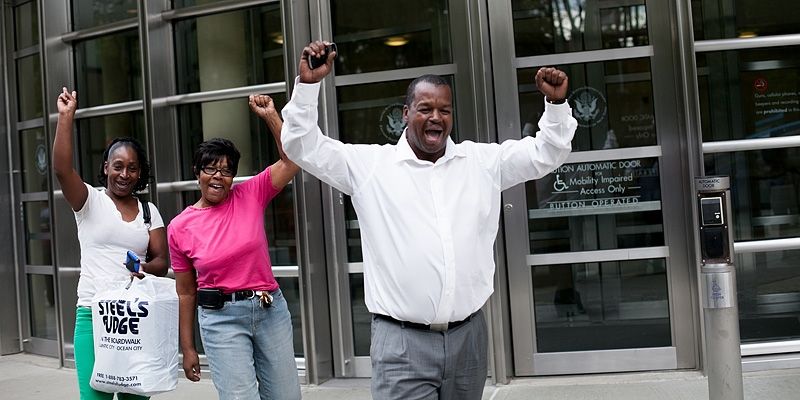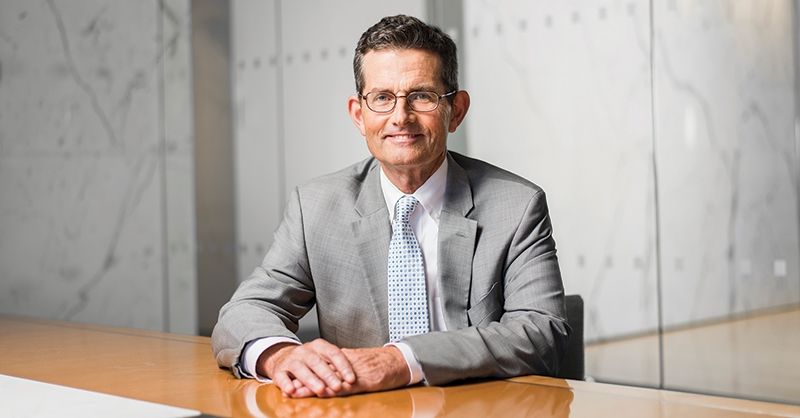John Gleeson ’80 earned respect during his public service career, both in his 21 years as a judge on the U.S. District Court for the Eastern District of New York and, before that, as a prosecutor. He was thoughtful in his decisions, though hardly soft on crime.
As David Patton, attorney-in-chief of the Federal Defenders in Brooklyn and Manhattan, put it in 2016 for a Politico article about Gleeson’s retirement from the bench, he “can’t be accused of just being a fuzzy-headed liberal.”
Gleeson served from 1985-1994 as an assistant U.S. attorney in the Eastern District of New York. Over time, he was chief of appeals, chief of special prosecutions, chief of organized crime and chief of the Criminal Division. He notably was lead counsel in the successful 1992 prosecution of crime boss John Gotti on racketeering charges and five murders.
But as a judge at least, Gleeson didn’t always agree with how prosecutors wielded their power under Title 18 of the U.S. Code, Section 924(c) — and the so-called “stacked” sentences the code produced. The law mandates lengthy prison terms for defendants convicted of using or possessing a firearm in connection with crimes involving violence or drug trafficking. Until the First Step Act was passed in December 2018, multiple 924(c) convictions required the imposition of mandatory consecutive 25-year sentences on each “second or successive” conviction.
Even for a young person, stacked 924(c) convictions could quickly result in a de facto life sentence. That is, if prosecutors brought all the potential firearm charges, and then refused to dismiss them because the defendant had exercised his right to trial by jury.
“I was a prosecutor once; I know how they think,” Gleeson said. “They’ve got that discretion. They use it to get people to plead guilty.”
In the summer of 2016, the law firm Debevoise & Plimpton, headquartered in New York City, called a meeting to discuss what it could do to address racial disparities in the criminal justice system. Having left the bench just a few months earlier, incoming partner Gleeson had an idea. He opened up a thick folder. The letters of desperate men serving stacked 924(c) sentences stared up at him. The men had written to Gleeson for help after he persuaded then-U.S. Attorney Loretta Lynch to agree to dismiss two convictions of a man he sentenced, Francois Holloway.

<p>Members of Francoise Holloway’s family celebrate in 2014 after a judicial hearing determined their loved one would be set free. <em>Anthony Lanzilote for The New York Times</em></p>
Gleeson suggested a pro bono effort that would ask other federal prosecutors, respectfully, if they would also agree to walk back some of their convictions.
From that seemingly quixotic proposal, the Holloway Project was born — a campaign that, as of this writing, has helped free 30 prisoners who would have otherwise been warehoused for the rest of their lives and largely forgotten by society.
So far, the project has reduced sentences by a collective 1,025 years.
FEDERAL PROSECUTORS CAN CLAIM an almost 100% conviction rate. About 97% of defendants plead guilty. Of the estimated 3% of cases that went to trial in 2018, according to the Pew Research Center, prosecutors won about 83% of the time.
While the number of Black prisoners in the federal prison system has been on the decline in recent years, with white prisoners currently making up the majority of the prison population, Black people serve more time than white people for comparable drug-related or violent crimes.
“The U.S. Sentencing Commission, which has not distinguished itself as a friend of criminal defendants over the years, has said over and over again that the DOJ for decades has been whipping out this stacked 924(c) power disproportionately against Black men,” Gleeson said. “Specifically, they said in 2011 to Congress, ‘Could you change this law please?’”
Living examples of the problem are men like Holloway. He ran a chop shop — a colloquialism for the black-market sale of parts from stolen cars. During a 24-hour spree in 1995, he carjacked three vehicles, and although an accomplice, not Holloway, had the gun, none of that mattered under Section 924(c), nor did it matter that they didn’t physically hurt anyone.
Holloway turned down a plea agreement that would have resulted in the dismissal of all but one 924(c) count and an 11-year prison sentence, insisting on a trial instead.
The jury found him guilty of three counts of carjacking and three counts of violating Section 924(c). Gleeson was the sentencing judge, and the law compelled him to impose 57 years in prison. Comparatively, Holloway’s armed co-conspirator, who pled guilty, would end up serving less than six years.
The outcome “haunted me for almost two decades” Gleeson wrote in a detailed history of The Holloway Project for the June edition of Federal Sentencing Reporter. In 2013, Gleeson, still a judge, lobbied Lynch to revisit the case.
Lynch “worked hard in response to the request, carefully considering Holloway’s impressive rehabilitation while incarcerated, contacting the victims of his crimes, and taking into account the excessive severity of his sentence,” Gleeson writes in the Reporter. “In July 2014, she exercised her discretion to grant my request, allowing me to reduce what was effectively a sentence of life without parole to a sentence of time served, giving Holloway the rest of his life back.”
The decision was precedent-setting.
While on the bench, Gleeson published a memorandum opinion describing the matter in great detail, which resulted in the outpouring of letters from prisoners in similar situations.
“I was struck by how moving the letters were and by how many I received,” he said. “There were hundreds of them.”
Yet when he and his colleagues launched the Holloway Project at Debevoise, making similar requests of prosecutors across the country, they didn’t encounter the same enthusiasm for walking back 924(c) convictions. Lynch’s decision appeared to be a one-off.

<p>Gleeson, a Thomas Jefferson Award winner for his contributions as a prosecutor and on the bench, is currently a partner at Debevoise & Plimpton.</p>
<div>
</div>
THE GROUND SHIFTED in December 2018, however, when the First Step Act became law, helping more federal prisoners become eligible for release. Passed with strong bipartisan support and backed by President Donald Trump, the legislation was the most important criminal justice reform measure in years.
“This legislation reformed sentencing laws that have wrongly and disproportionately harmed the African American community,” Trump said in his 2019 State of the Union address. “The First Step Act gives nonviolent offenders the chance to reenter society as productive, law-abiding citizens. Now, states across the country are following our lead. America is a nation that believes in redemption.”
The act made it clear that Congress never meant Section 924(c) stacking to apply to multiple convictions obtained in one case, which was what happened to Holloway and many others like him.
Still, from Gleeson’s perspective, that alone was of no help to the project. The change was retroactive only to the extent that it applied to cases in which sentences had not yet been imposed — which is to say not at all.
But another component of the act amended the federal sentence reduction statute, 18 U.S.C. Section 3582(c)(1)(a), allowing prisoners for the first time to pursue that relief directly, rather than having to channel their requests through the Federal Bureau of Prisons. That was where Gleeson saw an opportunity.
The only rub was that the request had to present “extraordinary and compelling” reasons, as outlined in one of the U.S. Sentencing Commission’s guidelines.
Prior to the First Step Act, the Bureau of Prisons had almost exclusively reserved its compassion for the old and infirm. When it was removed from its role as the gatekeeper, Gleeson and other advocates seized on the room for interpretation in the language of the statute and the applicable guideline. The fact that Trump and, so far, President Joe Biden, have left the commission’s bipartisan seats unfilled has precluded any official clarification.
Gleeson writes in the Federal Sentencing Reporter: “Our clients were serving breathtakingly long sentences that Congress never intended and had now abolished; though their offense conduct was serious, in almost all cases no one was hurt and little was stolen; most had received the sentences as a penalty for refusing to cooperate and/or for exercising the right to trial; they demonstrated extraordinary efforts to rehabilitate themselves in custody; and most were Black men who’d been subjected to a cruel mandatory enhancement that had been invoked by DOJ in a racially discriminatory fashion for decades. Really, what could be more extraordinary and compelling than that?”
Even within the scope of his accepted pro bono clients, not all cases were equal. The project began its advocacy by putting forward the cases it thought to have the strongest merit first.
“We were not going to lead with our chins,” Gleeson said.
PROSECUTORS DEFENDED the status quo on a number of fronts. Foremost, they contended, was that if Congress had intended its amendment to Section 924(c) to be retroactive, it would have said so. But the Holloway Project pointed out that it was relying on the section of the First Step Act that now allows a defendant “in any case” to petition for a sentence reduction. So even if the courts could not presumptively reduce the prison terms of all of the more than 2,500 inmates serving stacked 924(c) sentences — they could afford relief to the narrow subset of those cases presenting truly extraordinary and compelling circumstances.
The other argument made consistently by the government, Gleeson said, was that the Bureau of Prisons wouldn’t have agreed with the releases in the past. But Gleeson reminded the courts that the bureau was no longer a factor under the new regime, and indeed it had been removed by Congress from its prior gatekeeper role precisely because, he said, it had failed to open the gate as often as it should have.
The Law School contacted several current prosecutors for this article, but they declined or were unable to be quoted. The Department of Justice received a request for an official statement but did not provide one.
One former prosecutor said he wasn’t surprised either by how the government has reacted to cases like those brought by the Holloway Project, nor by why it might be hard to comment on the reform effort, due to the nuances of individual cases.
“I have some sympathy toward the prosecution viewpoint,” said William F. Gould ’90, a partner with Holland & Knight who was a federal prosecutor in the Western District of Virginia for more than a decade. “Those folks spent a lot of time and effort on prosecutions they felt were quite righteous. The sentencing guidelines try in some ways to put people in the appropriate sentencing box, but every case is personal. It’s hard to reduce that to a mathematical calculation. Judge Gleeson has been very involved in this area writ large and, in my opinion, has been a good leading force in the conversation as to whether sentences are appropriate.”
As of mid-September, the project had earned sentence reductions in 30 cases in the District Courts, with about as many more left to be decided and new prospective clients being vetted on an ongoing basis.
And earlier this year, that thing that never happens happened again: The U.S. attorney in Puerto Rico agreed to the project’s request for the release of a client who had already spent 30 years in prison.
Gleeson said the success has been gratifying, but still feels tenuous. While some prosecutors have decided not to appeal the judges’ decisions, others have. Some of the men could still be called back to prison. The project keeps up with its clients after their release to make sure they are complying with the terms of their probation.
“The harrowing part of this is the law could change,” Gleeson said. He added, “Most of our guys are out for good, but notices of appeal are what keep a lawyer up at night. The prospect that [a client] could be ordered back into prison for several decades is something to worry about.”
Even with that worry, he feels bullish about the long-term prospects for what he has pioneered — despite the “horse race on a couple of threshold legal questions.”
Currently, the government is appealing reductions in several cases. And Gleeson and his colleagues are seeking en banc and Supreme Court review of decisions in the Third, Sixth and Seventh Circuits. Those circuits have held that, because Congress did not make its amendment to Section 924(c) retroactive, judges cannot consider the amendment in deciding whether to reduce stacked sentences issued prior to First Step.
Gleeson said his pro bono mission has nothing to do with feelings of guilt about imposing the crushing sentences the statue had mandated. His hands were bound.
“I sleep well. It’s a defect in our system. We at Debevoise have devoted substantial pro bono resources to highlighting it and reversing its consequences in discrete cases. We are returning three-dimensional human beings who have righted themselves in prison, which is not easy to do, to families that love them and communities that missed them and need them. That they were subjected to excessive sentences that were visited by DOJ disproportionately on Black men makes the defect all the more repugnant.”
With other attorneys following his lead in bringing 924(c) cases, he’s now just one of many advocates pitching in to do the unstacking, and the unshackling.



